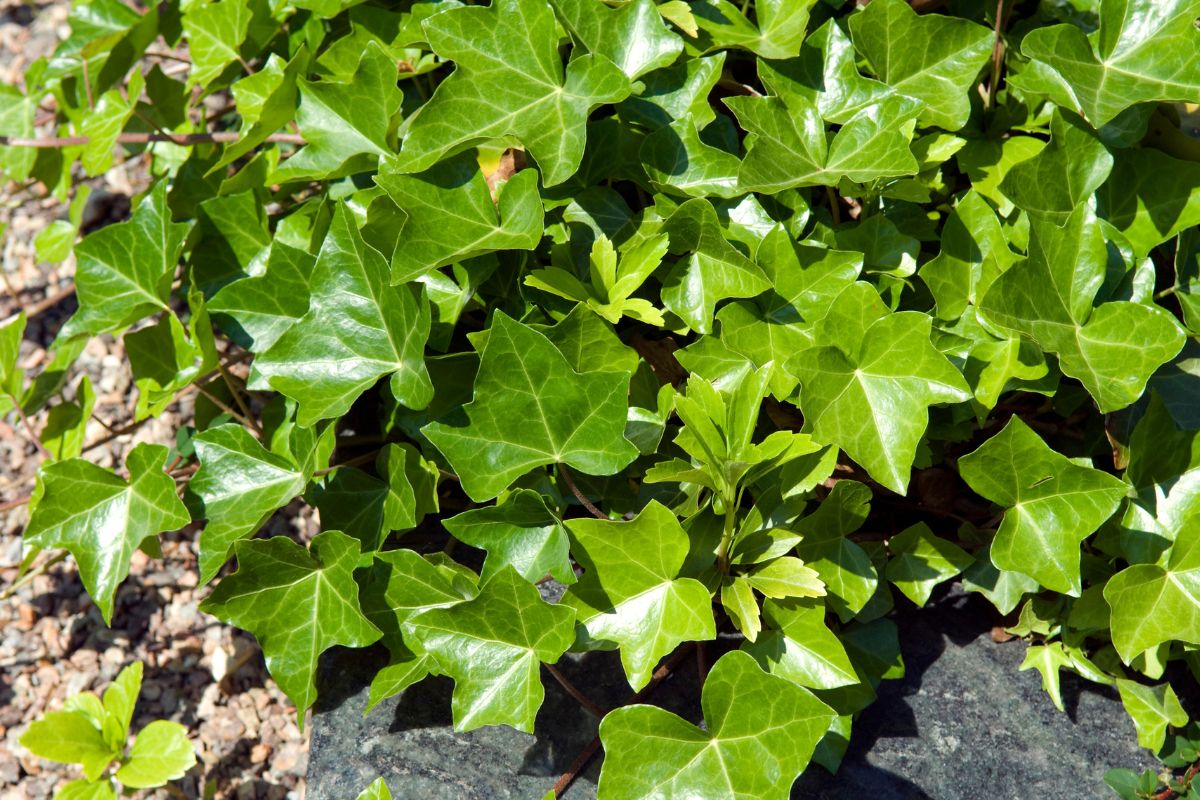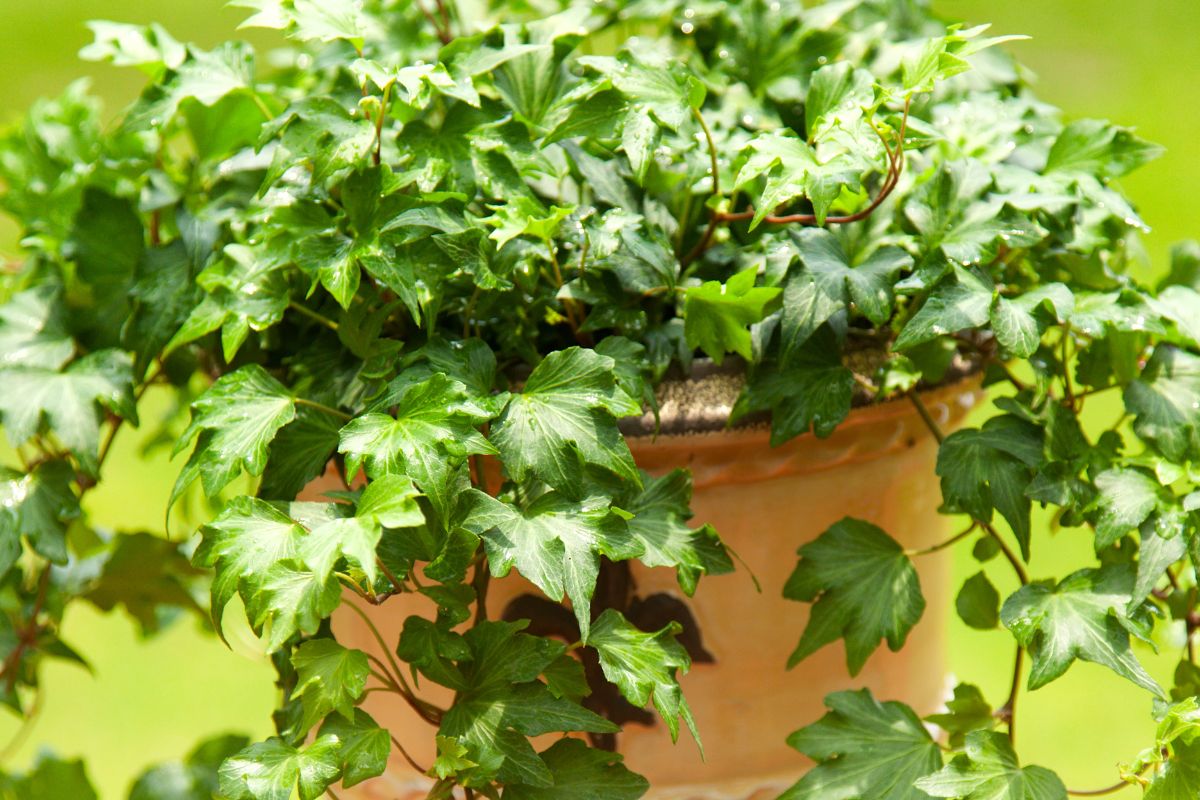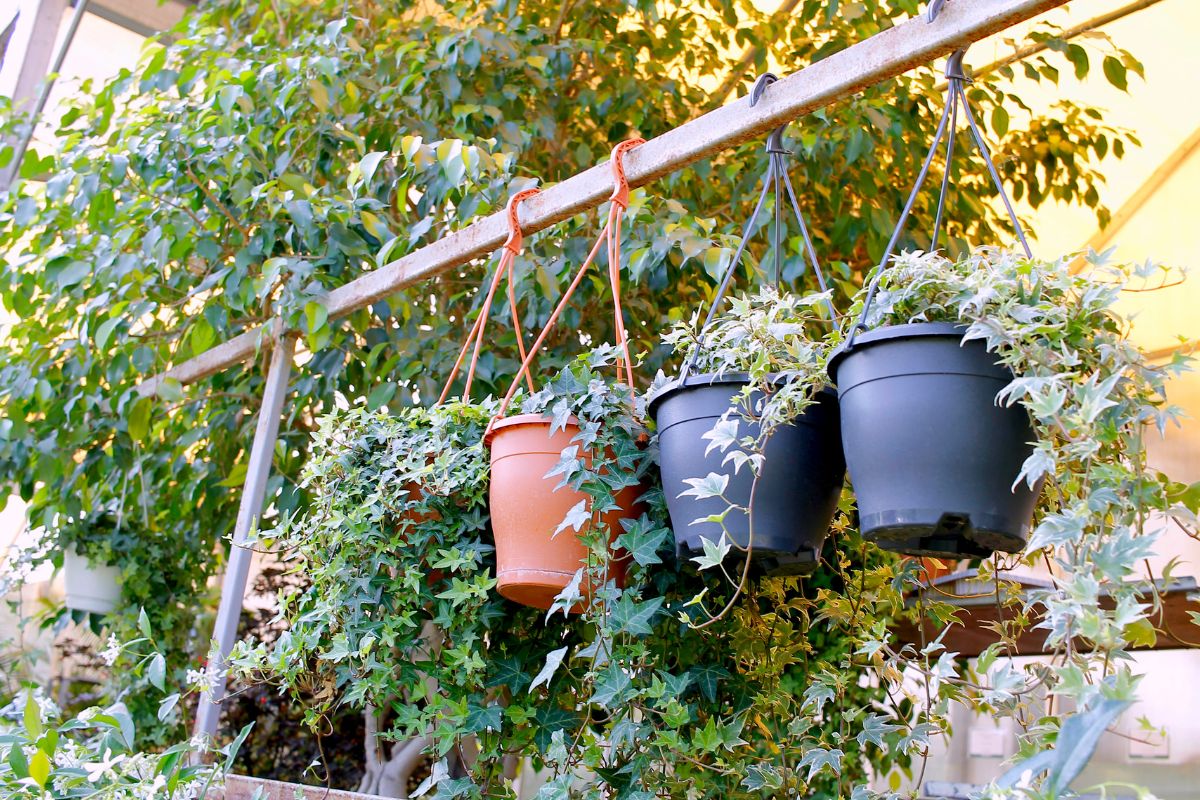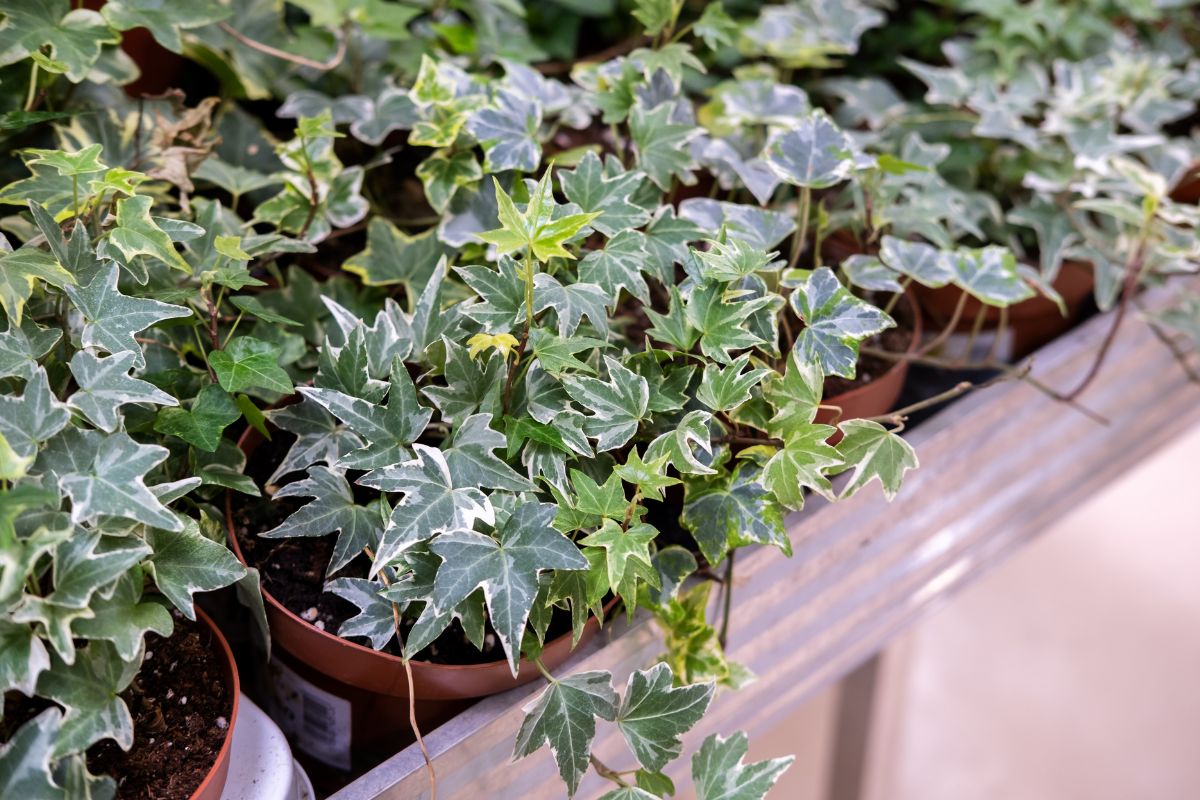Ivy plants are beautiful, elegant, and versatile. Ivy is a delightful plant that can brighten any room with its lush hanging vines and light airy appearance. Often grown outdoors, because it is considered invasive, it can cover entire walls and buildings quickly as it is a fast and aggressive grower.
When cultivated indoors, it brings a bit of the garden right into your home or office. It is not a difficult houseplant to cultivate indoors if you know how to care for the ivy. It will reward you with beautiful trailing vines that can grow to 50 feet or longer, filled with heart-shaped leaves in green or variegated patterns.
In this guide, you will learn how to grow and care for ivy plants.
Ivy Plant Overview

A perennial evergreen climber and member of the Araliaceae family, the most commonly found species “English Ivy” is native to Europe, Russia, and Scandinavia. The ivy has an extensive and lengthy history.
The ancient Romans held that ivy was sacred to the god Bacchus, the ancient Greeks to Dionysus, and a famous Christmas carol “The Holly and the Ivy” lends credence to its importance in times past.
Ivy can be found in several varieties:
- Hedera helix (English Ivy Plant) – This ivy is the most common type of houseplants sold in nurseries.
- Hedera Hibernica (Irish Ivy) – This type of Ivy is normally a bit larger than the hedera helix. Leaves are wider with green veins as opposed to white ones. The Irish Ivy type is also considered invasive.
- Hedera rhombea (Japanese Ivy) – A natural climber on cliffs, trees, and walls, Japanese ivy will feature green or green and white variegated leaves with reddish-purple stems.
- Herdera canariensis (Algerian Ivy) – Also called Canary Island Ivy, it is native to North Africa and comes in several variegated types. It is similar to English ivy for cultivation.
- Hedera colchica (Persian Ivy) – Featuring thick, large leathery leaves, this ivy is a nice alternative if you cannot grow grass. It is native to the western Caucasus and northern Turkey.
- Hedera nepalensis (Nepal Ivy) – Closely related to the hedera helix, it is native to eastern Asia and the Himalayas.
- Hedera pastuchovii (Russian Ivy) – Thin glossy light green leaves characterize this species. Found in parts of Russia and Iran, it is a climbing plant that will cling to any surface like its relatives.
The most common cultivar grown indoors and sold in nurseries is the English Ivy. Each of the indoor varieties also has several cultivars, so you will have quite an array of ivies to choose from.
There are many color options including lots of green variety shades, variegated green with white, yellow, cream, gray or black, as well as varying leaf shapes and growth.
If you have wish to cultivate it outdoors, ivy is an excellent plant option to cover up areas that might be unsightly. It will, however, require protection from the summer sun, and winter chill and winds.
Ivy Plant Care Guide
To cultivate an ivy plant indoors, know that it prefers cool evenings and good humidity. Some consider this a finicky houseplant, but with the right conditions, it’s a beautiful addition to indoor decor.
Ideally, this climber should be given a trellis or something to latch onto. It can also grow in hanging baskets where it can trail downwards. You can also create a wire cage or frame for a creative design.
Soil for the Ivy Plant
A well-draining soil bed of loose potting mix is the best option for growing a happy ivy plant. The plant can do well in various soil types with wide-ranging pH and nutrient levels.
As an indoor plant, it will thrive with an average loam soil bed. If you reside in an area with a dryer climate, add a layer of mulch on top to keep in moistness. The soil pH level should be neutral to slightly alkaline.
Light for the Ivy Plant

Your ivy plant will thrive in shade, both partial and full. This is one reason it does so well as a bedding plant and a ground cover plant at the base of trees.
Indoors, your plant will need bright light that is indirect during the summer and growing season. During the winter dormancy period, it can benefit from direct light when placed in a window.
Water and Humidity for the Ivy Plant
Ivy plants prefer soil that is a touch on the dry side, so check the soil bed before watering. Excellent drainage is a must for these plants. They should never be left standing in water or water-logged soil.
Ivy prefers medium to high humidity, so a humidifier or a pebble tray with water underneath the plant may be in order.
To create a humidity pebble tray, fill the tray with pebbles or stones and add water. Place the plant container on this tray of stones in a way that it sits above the water and does not touch it.
Frequent misting can help with the humidity level, and you can place it near other houseplants that require higher humidity to create an area to address the needs of these plants. Humidity can also be improved by positioning a bowl of water in the vicinity of the plant.
Temperature for the Ivy Plant
Ivy can grow in a wide range of temperatures, anywhere from 45° to 80° Fahrenheit. This plant does not appreciate very hot summer heat or cold winter winds and drafts.
Indoors, plants should be kept cool in the evening and nighttime, best is around or below 60°F.
Fertilizer for the Ivy Plant
During the spring and summer growing seasons, your ivy plant should be fed biweekly with a standard 20-20-20 water-soluble fertilizer.
If the plant is experiencing stress and not growing new leaves, avoid fertilizing. Stressful situations include a soil bed that is too hot, too cold, or too dry.
Pruning and Repotting Ivy Plants

Pruning will be necessary if you are growing your ivy outdoors as a ground covering or if it’s covering any openings. It should be trimmed in the spring and can be pruned to take on a bushy shape by pinching off newly grown tips.
Regular pruning will also discourage leaf spot bacteria. A radical pruning is encouraged every few years to revitalize your ivy plant.
If you find ivy climbing up one of your trees, you should cut the vine at the base of the soil bed where it is growing to cut off the water source. Avoid pulling it off the tree directly as it may damage it.
The ivy vine attached to the tree trunk will die naturally without access to water. You may need to repeat this process annually.
Indoor ivy plants can be trimmed as necessary depending on how you’d like your decor.
A smaller sized ivy plant will need to be repotted annually whereas a large plant can be repotted every two years. With each repotting, new soil should be used. If you have an older, more mature ivy, you can replace the soil in the same pot to give it a boost.
Propagating Ivy Plants
When you prune your ivy plant, use the cuttings to propagate new plants.
Stem cuttings should be approximately five inches in length. Place the ends in a glass of water and wait for root development. Once roots have grown you can transfer your new ivy into potting soil.
Ivy grown outside as a ground cover will develop roots where the vine touches the soil. Cut these sections of the vine with the roots. Dig them out to transfer them to a new container or location.
Ivy Plant Toxicity and Pets
Unfortunately, English ivy is toxic to humans, dogs, cats, and even horses. The ivy’s foliage containing triterpenoid saponins that is more poisonous than its berries. Poisoning symptoms may include:
- Abdominal pain
- Delirium
- Diarrhea
- Drooling or hypersalivation
- Fever
- Hallucinations
- Rash
- Vomiting
Should you see or suspect your pet ingested ivy, you should call your local poison control center or your veterinarian immediately.
Ivy Plant Pests, Diseases, and Problems

Both aphids and spider mites love English Ivy. They can easily be removed by spraying them off with water. Afterward, spray your ivy with neem oil or with insecticidal soap. For aphids, you can use a mixture of water and dish soap as an alternative.
Bacterial leaf spot (officially known as Xanthomonas) and Rhitzoctonia root rot are the two diseases that most often attack ivy.
Leaf spot will be characterized by dark brown or black spots on the leaves. For this disease, it is wiser to dispose of the infected plant. You can protect the remaining ivy by spraying it with a vinegar and water mixture with a 1 to 10 ratio.
Root rot is often a result of wet soil or hot humid weather, and is usually fatal. The sick plant should be removed and disposed of. The remaining ivy should be treated with a fungicide.
Another problem with the ivy plant is their fast growth and potential harm to the environment. In the US, it is considered an invasive species, and you may need to check with local regulations if you plan on growing ivy outdoors.
Ivy covers many “Ivy League” college buildings in the North East of the US. This tradition continues despite the fact that the popular English Ivy species is thought to provoke damage to trees, building facades, and brickwork.
Ivy Plant Care Final Thoughts
Ivy houseplants are a fast-growing, easy-to-care for houseplant. You may even want to hang one in your bathroom since they truly thrive with high humidity, shade, and varied temperatures.
It looks fantastic dangling from a hanging basket or from a high shelf in any home or office. The trailing vines and variegated leaves contribute to a great decor.
Read more about other houseplants and how to care for them.
Ivy Plant Care FAQs
Do ivy plants need direct sunlight?
Ivy plants love bright indirect light. It can take direct sunlight, but it’s not necessarily needed.
Is ivy a good indoor plant?
Yes! Ivy is a very hardy plant that does well indoors year round. It doesn’t take much to care for the ivy plant. Ivy makes for a great bathroom plant as it likes the high humidity.
Why is English ivy bad?
The English Ivy is bad because it contains toxins which cause vomiting, diarrhea, abdominal pains, fever, rashes, and other problems. If you have pets at home, make sure you keep away from the ivy plant because it could potentially harm or even kill your dog or cat.
Is ivy easy to grow?
Ivy is a low maintenance plant and easy to grow. All you really need to do is provide bright lighting and regular watering. Ivy grows fast, so you’ll know whether you’re taking good care of it or not.
How often should ivy be watered?
You don’t need to worry about how frequently you water your ivy plant. Just give it enough time between waterings. Ensure the soil isn’t too wet as overwatering will hurt the ivy, potentially leading to root rot.


